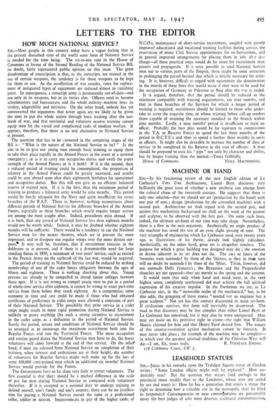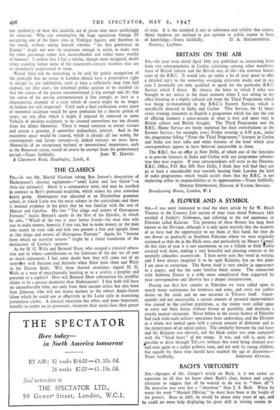LEASEHOLD STATUES
SIR,—Janus in his remarks upon the Trafalgar Square statue of Gordon writes: " Some London effigies might well be replaced." ,How un- deniably true! But the question that occurs (and perhaps to the provincial more readily than to the Londoner, whose eyes are sealed by use and wont) is: How far has a generation that erects a statue the right to determine how a valuable site in the metropolis shall be filled in perpetuity? Contemporaries or near contenloraries are presumably never the best judges of who most deserves sculptural commemoration.
nor (probably) of how this laudable act of pietas may most satisfyingly be achieved. Who can contemplate the huge equestrian George IV occupying one of the finest sites in Trafalgar Square, and therefore in the world, without asking himself whether " the first gentleman in Europe " might not now be courteous enough to retire, to make way for some personage rather less inconsiderable and rather more worthy of honour? I confess that I feel a similar, though more mitigated, doubt when standing before some of the nineteenth-century worthies who are so abundantly perpetuated in stone.
Would there not be something to be said for public recognition of the principle that no statue in London should have a prescriptive right to occupy its site indefinitely, until at least a sufficiently long time had elapsed, say fifty years, for informed public opinion to be satisfied (a) that the stature of the person commemorated is big enough and (b) that the statue of the person commemorated is fine enough, at least as a characteristic example of a style which of course might be no longer in fashion but still respected? Until such a final ratification, every piece of memorial sculpture would be upon probation for a shorter period of years, say ten, after which it might if rejected be removed to some Valhalla of obsolete sculpture, to be situated somewhere not too distant from the Albert Memorial. There it would continue to attract visitors and arouse a genuine, if somewhat melancholy, interest. And in the meantime space would be cleared, which is already all too scanty, for contemporary and future statuary—if, indeed statuary we must have. Memorials of an exceptional national or international importance, such as the Roosevelt statue, would of course be exempt from the probationary period.—Yours faithfully, JOHN W. HARVEY. 6 Claremont Road, Headingley, Leeds, 6.



































 Previous page
Previous page